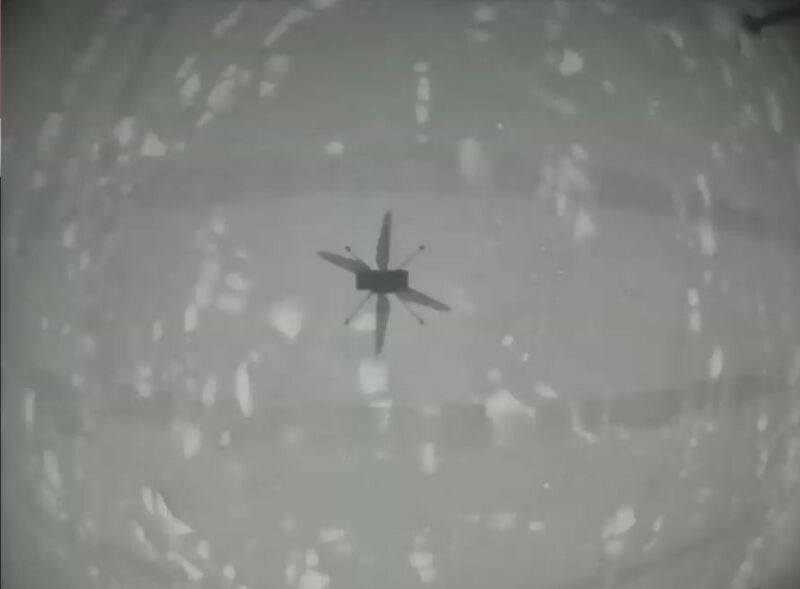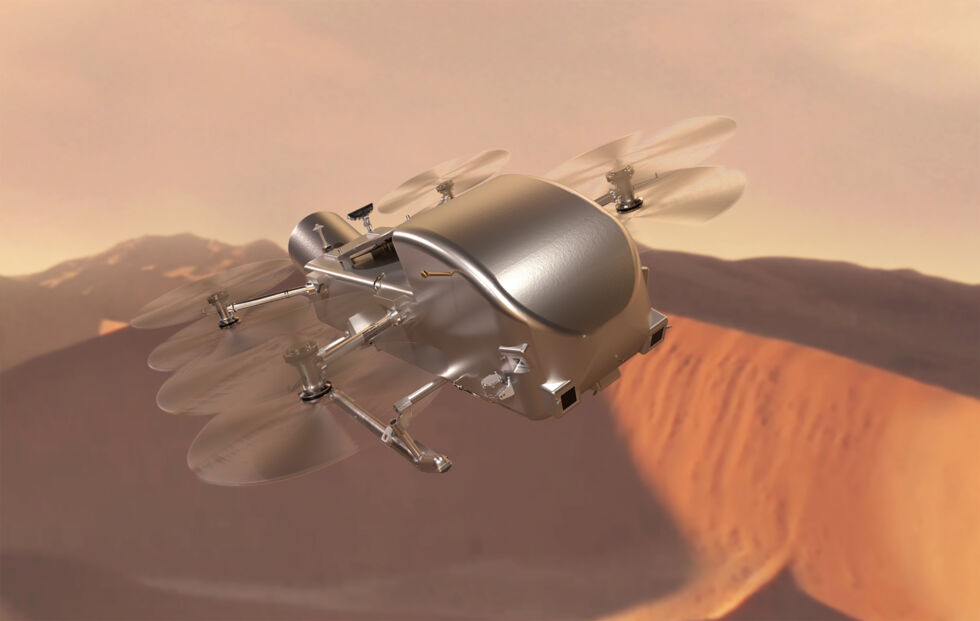Ingenuity packed more computing power than all other NASA deep space missions combined.

Much has been written about the plucky exploits of NASA’s small Ingenuity helicopter on Mars. And all of the accolades are deserved. “The little mission that could” did, flying 72 sorties across the red planet and pushing out the frontier of exploration into the unknown.
Yet as impressive as Ingenuity‘s exploits were over the last three years, and though its carbon fiber blades will spin no more, its work has only just begun.
Ingenuity was groundbreaking in two significant ways that will ripple through the culture of NASA and its exploration efforts for decades to come. Although it is impossible to know the future, both of these impacts seem overwhelmingly positive for our efforts to divine the secrets of our Solar System.
First of all, and most obviously, NASA has now demonstrated that powered flight is possible on other worlds. This is an idea that’s no longer theoretical; it’s grounded in reality. “Engineering has absolutely shattered our paradigm of exploration by introducing this new dimension of aerial mobility,” said Lori Glaze, NASA’s overall director of planetary science.
In another, arguably more important way, Ingenuity may forever change the way NASA, other space agencies, and eventually private companies explore and settle the Solar System. The program did so by using commercial, off-the-shelf parts.
The scientists and engineers who built the helicopter had no choice. Flying on Mars is incredibly demanding. The air is so thin it is equivalent to flying at an elevation of 80,000 feet on Earth, or three times higher than the peak of Mount Everest. Helicopters on Earth can max out at an altitude of about 25,000 feet before the air is too thin to support the rotation of their blades. So to meet the demands of Mars, Ingenuity‘s designers had to be ruthless in their choices. They could not afford the mass of radiation-hardened components, like for batteries and computers.
ADVERTISINGAdvertisement
So they bought commercially available parts and rolled the dice—with astonishing results. Many NASA missions will never be the same.
Let’s go flying
During a news conference on Thursday afternoon, Glaze and other NASA officials drew a comparison between Ingenuity and the 1903 Wright Flyer. Built by Orville and Wilbur Wright, this experimental aircraft made the first powered flight on Earth 120 years ago. It flew four times, achieving a distance of 852 feet (260 meters) on its final flight on December 17, 1903. After landing, high winds blew the airplane over and wrecked the vehicle.
On Mars, Ingenuity became the first vehicle to demonstrate powered flight on another planet. On its 72nd flight, one or more of its four blades was damaged during a hard landing on the red planet.
After the Wright Brothers demonstrated what was possible, designers in Europe and elsewhere continued to push the technology forward. By the time of World War I, aviation emerged as an important component of warfare and as a force in civilian transport a couple of decades later. Today, there are approximately 100,000 airplane flights that take off and land every day in the world. The transformation has been monumental.
Glaze and others envision a similar impact on human efforts to explore other worlds in the Solar System.

“As a Mars scientist, I dream of a helicopter exploring the canyons of Valles Marineris,” said Laurie Leshin, the director of the Jet Propulsion Laboratory, which managed the Ingenuity project. “This type of mobility can take us to places that we have never dreamed we’d be able to explore on Mars. And the possibilities are really endless.”
Valles Marineris is the largest canyon in the Solar System, measuring 2,500 miles long (4,000 km) and running more than 4 miles (7 km) deep. Due to its uneven and riven terrain, it is essentially inaccessible to traditional rovers.
Pushing the technology further
NASA already has big plans for flying machines on other worlds. Perhaps the most intriguing of these is the Dragonfly mission to the largest of Saturn’s moons, Titan. The vehicle, which the Johns Hopkins Applied Physics Laboratory in Laurel, Maryland, will build and operate, is scheduled to launch in July 2028.
It’s a bold and daring mission that seeks to fly an automobile-sized nuclear-powered drone over the organic-rich sands on Titan. There are some advantages to flying on Titan—its primarily nitrogen atmosphere is about 50 percent thicker than Earth’s at the surface. But even so, developing and flying such a large vehicle in a relatively unknown environment represents a huge challenge.

But if Ingenuity worked, there’s every reason to believe that Dragonfly can as well.
There are already plans in place to upgrade future Mars helicopters. The leader of the Ingenuity team at the Jet Propulsion Laboratory in Pasadena, California, Teddy Tzanetos, explained in an interview that every one of the vehicle’s flights on Mars provided valuable data. Before, engineers had theories about what to expect and how aircraft would perform, but now they have real-world data.
In an interview, Tzanetos said the next generation of Mars helicopters is already building on learnings from Ingenuity. As part of NASA’s current plans to return rock samples from the surface of Mars—which remain in flux due to funding issues—the space agency may use one or more of these flying machines to retrieve samples for a return to Earth.Advertisement
This will require increased performance, both in terms of flying further and carrying a heavier payload. Tzanetos said the new design increases the helicopter’s rotor length from 3.9 feet to 4.6 feet (1.2 to 1.4 meters). The rotors on Ingenuity spun fast, with their tips moving at a speed of Mach 0.65, or 65 percent of the speed of sound on the surface of Mars. The next generation will spin up to Mach 0.95.
“We’re really going to be running close to the speed of sound,” Tzanetos said. “So we’ll be pushing the limits.”
What are the limits?
The success of Ingenuity will unlock more mission planners to Mars and elsewhere to think about using aerial vehicles as part of their designs. The helicopter’s operators hope that Ingenuity opens the floodgates of what is possible, much as the Wright Flyer pushed enthusiasts and would-be aviators to broaden their imaginations more than a century ago.
“Now that we know this capability is possible, we will push the boundaries of what we can do,” Glaze said.
Some planetary scientists have long dreamed of deploying and flying a balloon or similar vehicle in the Venusian atmosphere. Near the surface of the hellishly hot world, the atmosphere is crushing. But higher up, there are atmospheric pressures very much like those on Earth, which would make long-term exploration by a balloon-like vehicle fruitful.
Each world presents its own challenges and opportunities. The exceedingly thin atmosphere on Mars is offset, slightly, by the reduction of gravitation force. It is about one-third that of Earth, so it will make technologies like fixed-wing aircraft and other flying machines more possible.
Aerial mobility has implications for astronauts as well. Human missions to Mars are likely to use helicopters or drones to survey terrain before they venture out on foot or in a rover. If there are multiple base camps, fleets of small aircraft could deliver packages among them. And, one day, humans will be able to fly across the planet’s surface.
Buying commercial works
As cool as Ingenuity‘s flight log may be, the better story may be how the engineers at NASA’s Jet Propulsion Laboratory did it. Due to the aforementioned thin atmosphere, the team was constrained to a mass of just 4 pounds (less than 2 kg) for the entire helicopter. That is the equivalent of approximately five cans of Campbell’s soup.
Those five cans of soup include your helicopter blades, which are several feet long, the batteries, the computer, the sensors and camera, the legs, the solar panel—all of it.
So, how did the team do it? They ditched traditional, space-rated hardware. They just couldn’t take the mass penalty. For example, the RAD750 computer that operates most modern spacecraft—including the Perseverance rover—weighs more than 1 pound. They couldn’t blow that much mass on the computer, even if it was designed specifically for spaceflight and was resistant to radiation.
Instead, Tzanetos said Ingenuity uses a 2015-era smartphone computer chip, a Qualcomm Snapdragon 801 processor. It has a mass of half an ounce.
The RAD750, introduced in 2001, is based on 1990s technology. The modern Qualcomm processor was designed for performance and has the benefit of 20 years of advancement in microprocessor technology. In addition to being orders of magnitudes cheaper—the RAD750 costs about a quarter of a million dollars, while the Qualcomm processor goes into inexpensive mobile phones—the newer chip has bucketloads of more performance.Advertisement
“The processor on Ingenuity is 100 times more powerful than everything JPL has sent into deep space, combined,” Tzanetos said. This means that if you add up all of the computing power that has flown on NASA’s big missions beyond Earth orbit, from Voyager to Juno to Cassini to the James Webb Space Telescope, the tiny chip on Ingenuity packs more than 100 times the performance.
A similar philosophy went into other components, such as the rechargeable batteries on board. These are similar to the lithium batteries sold in power tools at hardware stores. Lithium hates temperature cycles, and on the surface of Mars, they would be put through a hellish cycle of temperatures from -130° Fahrenheit (-90° C) to 70° (20° C).
The miracle of Ingenuity is that all of these commercially bought, off-the-shelf components worked. Radiation didn’t fry the Qualcomm computer. The brutal thermal cycles didn’t destroy the battery’s storage capacity. Likewise, the avionics, sensors, and cameras all survived despite not being procured with spaceflight-rated mandates.
“This is a massive victory for engineers,” Tzanetos said.
Indeed it is. While NASA’s most critical missions, where failure is not an option, will likely still use space-rated hardware, Ingenuity‘s success opens a new pathway for most science missions. They can be cheaper, lighter, and higher-performing in every way. This is almost unimaginably liberating for mission planners.
Ingenuity’s legacy
The concept of flying Ingenuity came along at just the right time, in the early 2010s, as NASA was finalizing the payloads that would fly on the Perseverance rover to Mars in 2020. When NASA had to make the call on whether or not to fly the technology demonstration mission, the right mix of technologies was coming online: high energy density batteries, high-performance processors for mobile devices, lightweight cameras, and MEMS accelerometers to measure acceleration.
These devices were pushed and perfected as part of the mobile phone revolution. If there had been no iPhone, there would have been no Ingenuity. It was the perfect confluence, and it resulted in the miracle on Mars.
As a middle-aged space reporter, I have naturally become a little jaded over time as I have watched NASA and other space agencies around the world take two steps forward and one step back. Space is hard. Battling through bureaucracy is hard. There is a lot of BS out there in the space industry.
But the launch, deployment, and astonishing performance of Ingenuity during the last three years has truly taken my breath away. It is a phenomenal engineering achievement and a real triumph of the engineers over some in NASA management who never wanted Ingenuity to fly. As Americans, as humans, we can all be proud to witness flight on another world.Advertisement
It’s a perilous exercise to judge history while being in the middle of history, of course. But I would rate Ingenuity among the three most innovative and important things that NASA has done during the 21st century. The other two are the James Webb Space Telescope and the Commercial Orbital Transportation Services, or COTS, program.

Webb is an obvious choice, as it is the most complex and costly scientific instrument NASA has ever put into space. It represents the pinnacle of the classic NASA way of doing things: very costly and very delayed, but also very ambitious and very successful. In less than a full year of operations, Webb has already dazzled and enlightened us.
COTS may be less obvious, but it’s important for other reasons. Ostensibly, it provided a few hundred million dollars to SpaceX and Orbital Sciences to develop spacecraft to deliver supplies to the International Space Station. But more than that, COTS is undoubtedly responsible for SpaceX’s early growth, and the program and its successors saved the company from bankruptcy. With NASA’s new model for buying services and SpaceX’s validation of this approach, this program launched the transformative commercial space era we’re enjoying today.
By demonstrating flight on another planet and cracking the code on off-the-shelf components, Ingenuity easily stands alongside these two grand achievements.




